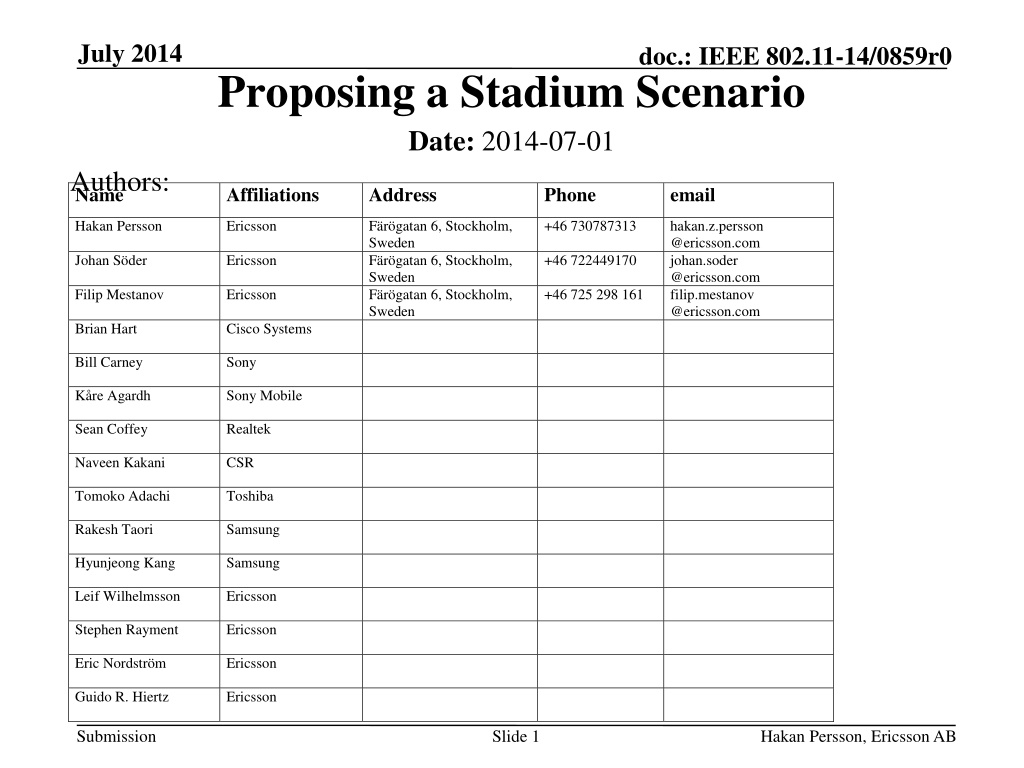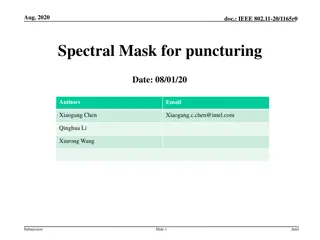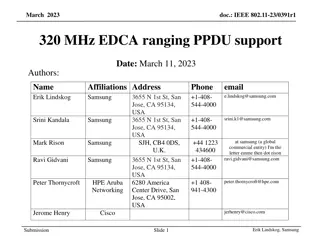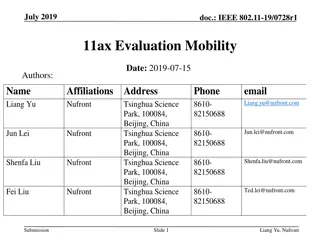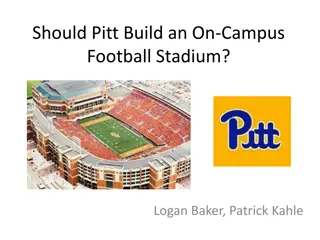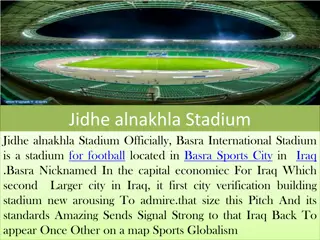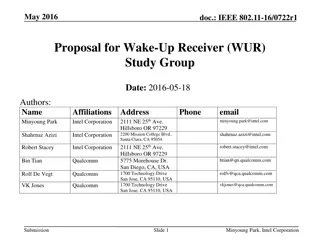Proposal for Stadium Scenario in IEEE 802.11-14 Standard
This document proposes the inclusion of a stadium scenario in the IEEE 802.11-14 standard, highlighting the importance of addressing the challenges posed by high-density Wi-Fi environments like stadiums. The concept explores the unique requirements of stadiums, such as a large number of access points, high interference levels, and significant bandwidth demands. Discussions revolve around the necessity for a separate simulation use case for stadiums due to their distinctive characteristics. The document also includes inputs from the Wi-Fi Alliance regarding the significance of addressing stadium scenarios to prevent network bottlenecks by 2020.
Download Presentation

Please find below an Image/Link to download the presentation.
The content on the website is provided AS IS for your information and personal use only. It may not be sold, licensed, or shared on other websites without obtaining consent from the author. Download presentation by click this link. If you encounter any issues during the download, it is possible that the publisher has removed the file from their server.
E N D
Presentation Transcript
July 2014 doc.: IEEE 802.11-14/0859r0 Proposing a Stadium Scenario Date: 2014-07-01 Name Authors: Affiliations Address Phone email Hakan Persson Ericsson F r gatan 6, Stockholm, Sweden F r gatan 6, Stockholm, Sweden F r gatan 6, Stockholm, Sweden +46 730787313 hakan.z.persson @ericsson.com johan.soder @ericsson.com filip.mestanov @ericsson.com Johan S der Ericsson +46 722449170 Filip Mestanov Ericsson +46 725 298 161 Brian Hart Cisco Systems Bill Carney Sony K re Agardh Sony Mobile Sean Coffey Realtek Naveen Kakani CSR Tomoko Adachi Toshiba Rakesh Taori Samsung Hyunjeong Kang Samsung Leif Wilhelmsson Ericsson Stephen Rayment Ericsson Eric Nordstr m Ericsson Guido R. Hiertz Ericsson Submission Slide 1 Hakan Persson, Ericsson AB
July 2014 doc.: IEEE 802.11-14/0859r0 Abstract Stadium has been acknowledged as a important use case for the ax-technology. This document provides some reasons why Stadium should be included as one scenario in the Simulation scenario document Submission Slide 2 Hakan Persson, Ericsson AB
July 2014 doc.: IEEE 802.11-14/0859r0 About the Stadium concept Presented in IEEE 11-14/0381r0, (Sony and Ericsson; March meeting) March meeting response summary : Further discussions if stadiums justify a separate simulation use case or are subsumed in outdoor A stadium concept cover the aspects: Several hundreds of APs concentrated in small area High number of overheard STAs / APs 50,000 100,000 potential users (and active) Very high interference levels and a raised noise floor One AP typically covers 25 150 seats Traffic demands are in the order of hundreds of GB/hour during an event Outdoor scenario Deployments using directional antennas Submission Slide 3 Hakan Persson, Ericsson AB
July 2014 doc.: IEEE 802.11-14/0859r0 About the Stadium concept Thus it serves the purpose of evaluating a very difficult use case: Users ultra-close to each other (many STAs close to each other) LoS environment (increasing OBSS problem) High bandwidth demands UL/DL coverage asymmetry Directional at AP and Omni-antenna at STA At last meeting some measurement results was presented IEEE 11-14/0682r0 showing some relevant issues related to stadium deployments Submission Slide 4 Hakan Persson, Ericsson AB
July 2014 doc.: IEEE 802.11-14/0859r0 Wi-Fi Alliance input In the Liaison from Wi-Fi Alliance HEW Use Cases (IEEE 802.11-13/1443r0) the Stadium scenario had the highest ranking to create WiFi network bottlenecks in 2020 time frame. Submission Slide 5 Hakan Persson, Ericsson AB
July 2014 doc.: IEEE 802.11-14/0859r0 Current content (IEEE 802.11-14/0621r4) Channel ~Traffic Scenario Name Topology Management Homogeneity Model Model A - Apartment building e.g. ~10m x 10m apartments in a multi- floor building ~10s of STAs/AP, P2P pairs 1 Residential Unmanaged Indoor Flat Home B - Dense small BSSs with clusters e.g. ~10-20m inter AP distance, ~100s of STAs/AP, P2P pairs 2 Enterprise Enterprise Managed Indoor Flat C - Dense small BSSs, uniform e.g. ~10-20m inter AP distance ~100s of STAs/AP, P2P pairs 3 Indoor Small BSS Hotspot Mobile D - Large BSSs, uniform e.g. 100-200m inter AP distance ~100s of STAs/AP, P2P pairs 4 Outdoor Large BSS Hotspot Managed Flat Mobile Outdoor Outdoor Large BSS Hotspot + Residential Mobile + Home Managed + Unmanaged 4a D+A Hierarchical Does the Indoor Small BSSs Scenario scenario cover Stadium aspects? Outdoor Large BSS Hotspot does not (since large-sized BSS) Slide 6 Submission Hakan Persson, Ericsson AB
July 2014 doc.: IEEE 802.11-14/0859r0 Comparing w/ Stadium scenario Channel ~Traffic Scenario Name Topology Management Homogeneity Model Model C - Dense small BSSs, uniform e.g. ~10-20m inter AP distance ~100s of STAs/AP, P2P pairs Indoor Small BSS Hotspot Managed Indoor Flat Mobile 3 D - Large BSSs, uniform e.g. 100-200m inter AP distance ~100s of STAs/AP, P2P pairs E Dense small BSSs, uniform distribution (at pre-defined seats) e.g.~10-20m inter AP distance ~100s of STAs/AP, P2P pairs Outdoor Large BSS Hotspot 4 Managed Flat Mobile Outdoor New proposed 5 Stadium Managed Flat Mobile Differences: Sector (directional) coverage of APs LoS channel model Users are placed within tens of centimeters between each other The overhearing overlap between BSSs is large, creating many OBSS and hidden nodes issues Submission Slide 7 Hakan Persson, Ericsson AB
July 2014 doc.: IEEE 802.11-14/0859r0 Issue: Directional antennas at APs Reference case: Regular, Omni antenna Shape of STA coverage (Not showing actual coverage) UL and DL AP1 coverage AP1 STA1 Overlapping BSSs issue STA to STA STA1 STA2 AP1 AP2 AP2 STA2 AP2 coverage STA may not detect transmissions from other APs STA may detect transmissions from other APs Non-symmetric coverage of APs and STAs Directional antennas at APs provides isolation between neighbour AP coverage areas; Omni-antennas at STAs spread radio signals in all directions Uplink and downlink unbalances are introduced in the stadium case Issue example: STA in another BSS cannot discover another BSS/AP DL transmission and may start an interfering transmission reducing overall spectrum efficiency RTS/CTS mechanism is not assumed as being used in practice Submission Slide 8 Hakan Persson, Ericsson AB
July 2014 doc.: IEEE 802.11-14/0859r0 Issues with other scenarios not being sufficient 1) Need for consideration of UL/DL imbalance a) power b) range c) topology d) carrier sensing range 2) Higher user density 3) Massive multicast usage 4) High UL traffic demand (photo uploads etc.) Submission Slide 9 Hakan Persson, Ericsson AB
July 2014 doc.: IEEE 802.11-14/0859r0 How to capture Options: 1. Include a new scenario with typical stadium deployment. Supporting denser network, LoS channel model, many OBSS and hidden node effects Capturing also directional antenna deployment, UL/DL asymmetry coverage effects 2. Modify/include a channel model in scenario 3 Indoor BSS Hotspot that is more suited for stadium case (such as increase the LoS distance) The high level of OBSS interference may still not be covered; needs also high density STA placement within each BSS But, no sector/directional deployments; missing coverage asymmetry effects A new scenario seems more appropriate to capture all effects within same test environment, creating a challenging test case to evaluate performance Submission Slide 10 Hakan Persson, Ericsson AB
July 2014 doc.: IEEE 802.11-14/0859r0 References https://mentor.ieee.org/802.11/dcn/14/11-14-0381-00- 0hew-stadium-scenario-for-hew.ppt https://mentor.ieee.org/802.11/dcn/13/11-13-1443-00- 0hew-liaison-from-wi-fi-alliance-on-hew-use-cases.ppt https://mentor.ieee.org/802.11/dcn/14/11-14-0621-04-00ax- simulation-scenarios.docx https://mentor.ieee.org/802.11/dcn/14/11-14-0682-00-00ax- in-situ-spectrum-reuse-measurements-in-indoor-20- 000-seat-arena.pptx Submission Slide 11 Hakan Persson, Ericsson AB
July 2014 doc.: IEEE 802.11-14/0859r0 Straw poll Do you agree to include the text in document 11-14/0860r0 in simulation scenario document? Yes: 66 No: 25 Abstain: 48 Submission Slide 12 Hakan Persson, Ericsson AB
